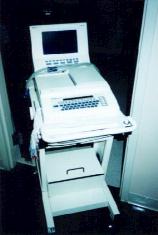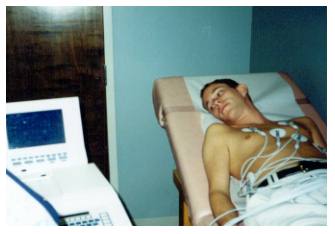


 Electrocardiography includes a few procedures which enable physicians
to better understand the inner workings of the body without actually
performing surgery or other invasive procedures. Electrocardiography
is a means of measuring the electrical activity within the body. As
you probably know, the body's nervous system is largely an electrical
power line. Electrical currents are sent throughout the body,
especially to muscles such as the heart, in order to make them
function. Tests which use this technology include an
Electrocardiogram (ECG or EKG), Signal Averaged Electrocardiograms
(SAECG) and Holter Monitoring. Each test has benefits in determining
potential health problems just by examining the results of the body's
electrical output because some heart conditions can create abnormal
electrical outputs.
Electrocardiography includes a few procedures which enable physicians
to better understand the inner workings of the body without actually
performing surgery or other invasive procedures. Electrocardiography
is a means of measuring the electrical activity within the body. As
you probably know, the body's nervous system is largely an electrical
power line. Electrical currents are sent throughout the body,
especially to muscles such as the heart, in order to make them
function. Tests which use this technology include an
Electrocardiogram (ECG or EKG), Signal Averaged Electrocardiograms
(SAECG) and Holter Monitoring. Each test has benefits in determining
potential health problems just by examining the results of the body's
electrical output because some heart conditions can create abnormal
electrical outputs.

|
|
|

 The ECG (or EKG as it is often called), is a graphic representation
of the electrical impulses that the heart generates during the
pumping of the heart. These electrical impulses are conducted to
the body's surface, where they are detected by electrodes placed on
the patient's limbs and chest. The monitoring electrodes detect the
electrical activity of the heart from a variety of perspectives. The
EKG lead system is composed of several electrodes that are placed on
each of the four limbs and at varying sites on the chest. Each
combination of electrodes is called a lead.
The ECG (or EKG as it is often called), is a graphic representation
of the electrical impulses that the heart generates during the
pumping of the heart. These electrical impulses are conducted to
the body's surface, where they are detected by electrodes placed on
the patient's limbs and chest. The monitoring electrodes detect the
electrical activity of the heart from a variety of perspectives. The
EKG lead system is composed of several electrodes that are placed on
each of the four limbs and at varying sites on the chest. Each
combination of electrodes is called a lead.

 The ECG is recorded on special paper with a graphic background of
horizontal and vertical lines for rapid measurement of time intervals
The ECG is recorded on special paper with a graphic background of
horizontal and vertical lines for rapid measurement of time intervals

|
|
|

 Through the analysis of these waveforms and time intervals, valuable
information about the heart may be obtained. This test can be
likened to a snapshot of the heart with a camera. The ECG is used
primarily to identify abnormal heart rhythms (arrhythmias) and to
diagnose acute myocardial infarction (heart attack), conduction
defects, and ventricular hypertrophy. It is important to note that
the ECG can be normal even in the presence of heart disease, as long
as the disorder is not affecting the heart's electrical activity at
the time the ECG is taken.
Through the analysis of these waveforms and time intervals, valuable
information about the heart may be obtained. This test can be
likened to a snapshot of the heart with a camera. The ECG is used
primarily to identify abnormal heart rhythms (arrhythmias) and to
diagnose acute myocardial infarction (heart attack), conduction
defects, and ventricular hypertrophy. It is important to note that
the ECG can be normal even in the presence of heart disease, as long
as the disorder is not affecting the heart's electrical activity at
the time the ECG is taken.
 For some patients at high risk for malignant ventricular
dysrhythmias, a signal-averaged electrocardiogram (SAECG or SAEKG)
can be performed. This test averages several hundred waveform
patterns of the typical ECG to detect late potentials (transmissions
of electrical impuses) that are likely to lead to ventricular
dysrhythmias. SAECG's have been a useful precursor to
electrophysiologic studies because they can identify patients with
unexplained syncope (blackouts/fainting) who may have ventricular
tachycardias induced by the electrophysiologic study. SAECG's can
be performed by the bedside in approximately 15 to 20 minutes.
For some patients at high risk for malignant ventricular
dysrhythmias, a signal-averaged electrocardiogram (SAECG or SAEKG)
can be performed. This test averages several hundred waveform
patterns of the typical ECG to detect late potentials (transmissions
of electrical impuses) that are likely to lead to ventricular
dysrhythmias. SAECG's have been a useful precursor to
electrophysiologic studies because they can identify patients with
unexplained syncope (blackouts/fainting) who may have ventricular
tachycardias induced by the electrophysiologic study. SAECG's can
be performed by the bedside in approximately 15 to 20 minutes.

|
|
|

 Unlike the relatively short electrical studies of the ECG and the
SAECG, holter monitoring is designed to take 24 hours. It is a
continuous recording of the electrical activity of the heart during
all daily routines such as rest, unrestricted activity, and
sleep. With this technique, an electrocardiogram is recorded
continuously but on magnetic tape instead of on ECG paper. The
monitor is equipped with a clock that permits accurate time
monitoring on the ECG tape. The patient is asked to carry a diary
and record all daily activities and well as any cardiac problems
during the monitoring period. This aids the technician who
interprets the results in finding particular cardiac problems the
patient may have had at certain times during the day.
Unlike the relatively short electrical studies of the ECG and the
SAECG, holter monitoring is designed to take 24 hours. It is a
continuous recording of the electrical activity of the heart during
all daily routines such as rest, unrestricted activity, and
sleep. With this technique, an electrocardiogram is recorded
continuously but on magnetic tape instead of on ECG paper. The
monitor is equipped with a clock that permits accurate time
monitoring on the ECG tape. The patient is asked to carry a diary
and record all daily activities and well as any cardiac problems
during the monitoring period. This aids the technician who
interprets the results in finding particular cardiac problems the
patient may have had at certain times during the day.
 Many units today have a "event marker" button that the patient may
press during any chest pain, dizziness, palpitations, etc. so that
the technician can easily find the ECG recording for such problems
and interpret the possible causes. Such devices are called event
recorders.
Many units today have a "event marker" button that the patient may
press during any chest pain, dizziness, palpitations, etc. so that
the technician can easily find the ECG recording for such problems
and interpret the possible causes. Such devices are called event
recorders. 
 The holter monitor is used primarily to identify suspected cardiac
rhythm disturbances and to correlate these disturbances with symptoms
the patient experiences. The monitor is also useful in assessing
pacemaker functions and of the effectiveness of antiarrhythmic
medications.
The holter monitor is used primarily to identify suspected cardiac
rhythm disturbances and to correlate these disturbances with symptoms
the patient experiences. The monitor is also useful in assessing
pacemaker functions and of the effectiveness of antiarrhythmic
medications.


|








|

|